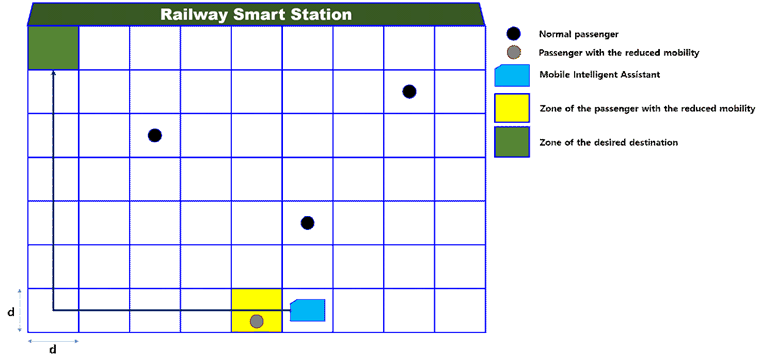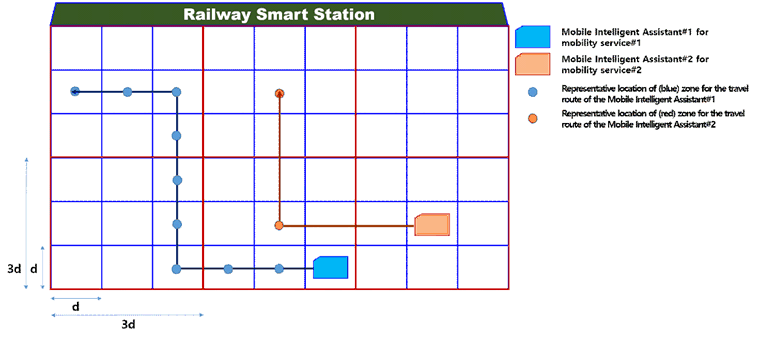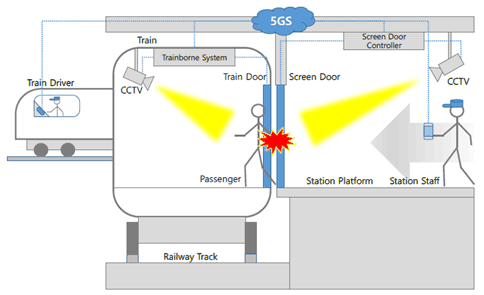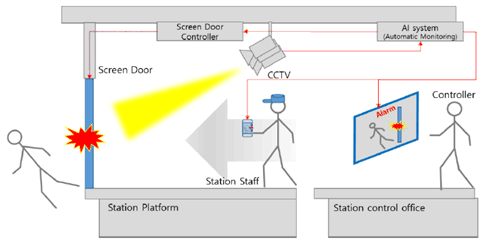Content for TR 22.890 Word version: 19.0.0
6 Business communication applications related use cases
6.1 Transportation convenience service for the passengers for the reduced mobility
6.2 Smart kiosk of Railway Smart Station
6.3 Multiple concurrent mobility services
6.4 Operation of platform screen doors
6.5 Automatic monitoring of Railway Smart Station
6 Business communication applications related use cases p. 11
6.1 Transportation convenience service for the passengers for the reduced mobility p. 11
6.1.1 Description p. 11
In the Railway Smart Station, a transportation convenience service for the passengers with the reduced mobility can be feasible, such as a mobility service for the passengers to arrive at the desired destination.

Figure 6.1.1-1: Example of transport convenience service for passenger with reduced mobility
(⇒ copy of original 3GPP image)
(⇒ copy of original 3GPP image)
6.1.2 Pre-conditions p. 12
- There exist feasible Mobile Intelligent Assistants in the Railway Smart Station, where the Mobile Intelligent Assistants support 3GPP system.
- The Mobile Intelligent Assistants are operated under the central control system via 3GPP access.
- There is at least one passenger with reduced mobility in the Railway Smart Station, where the weak passenger has difficulty moving toward the desired destination.
- The passenger has an equipment supporting 3GPP access.
6.1.3 Service Flows p. 12
- A passenger with reduced mobility is reserved in advance, where a Railway Smart Station already knows that the passenger needs help to get to the desired destination.
- Once the passenger enters the Railway Smart Station, one Mobile Intelligent Assistant stands by for mobile support to the desired destination.
- The Mobile Intelligent Assistant takes the passenger to the desired place.
6.1.4 Post-conditions p. 12
- The Railway Smart Station traces and manages the route of movement of the passenger with reduced mobility.
6.1.5 Existing features partly or fully covering the use case functionality p. 12
[R-5.11-001]
The MCX Service shall support obtaining and conveying Location information describing the position of the MCX UE.
[R-5.11-002]
The MCX Service should support obtaining and conveying high accuracy Location information describing the position of the MCX UE.
[R-5.11-002a]
The MCX Service shall be able to provide a mechanism for obtaining high accuracy Location information by integrating position information from multiple external sources (e.g. magnetometers, orientation sensors, GNSS)
[R-5.11-003]
The MCX Service shall provide for the flexibility to convey future formats of Location information.
[R-6.12-002]
The MCX Service shall support conveyance of Location information provided by 3GPP location services.
6.1.6 Potential New Requirements needed to support the use case p. 13
[R-6.1.6-1]
The MCX service shall be able to support obtaining and conveying location information as a scalable zone information describing the position of the MCX UE.
6.2 Smart kiosk of Railway Smart Station p. 13
6.2.1 Description p. 13
A smart kiosk in the railway smart station provides various information to passengers, such as location information service with 3D or metaverse enabled station map, simple ticketing service, and other information providing services via interfacing smart station devices and systems, e.g. CCTV, sensors.
The kiosk co-operates with a Mobile Intelligent Assistant such as robot, to support passengers if the kiosk operating system decides that it is necessary.
6.2.2 Pre-conditions p. 13
A passenger has ticketed of a train.
A passenger has a UE, which is a Railway Smart Station service enabled.
A kiosk has a UE, which is a Railway Smart Station service enabled.
A Mobile Intelligent Assistant has a UE, which is a Railway Smart Station service enabled.
A passenger has made a permission to handle his/her identification to FRMCS, such as the smart station system.
6.2.3 Service Flows p. 13
- A passenger is standing in front of a smart kiosk to search his train's platform.
- The passenger's UE make a proximity connection with the kiosk or vice versa by using 5G Off-network communication.
- The passenger sends identification information of the passenger (e.g. customer id) or the train.(e.g. train number).
- The kiosk shows the path to the platform of the train with 3D or metaverse enabled map of the smart station and transmits the information to the passenger's UE.
- The passenger gets physical ticket or receipt from the kiosk and the passenger is a transport vulnerable, asks guidance to the kiosk by the Mobile Intelligent Assistant, a.k.a. guidance robot of the smart station.
- The kiosk asks the location of the Mobile Intelligent Assistant to the FRMCS, and arranges the closest one to the passenger and bring the Mobile Intelligent Assistant the passenger, for example, in front of the kiosk.
- The Mobile Intelligent Assistant comes to the passenger and confirms the identification information of the passenger by connecting the UE via 5G Off-network communication of the passenger.
- The passenger gets on the Mobile Intelligent Assistant and moves to the platform.
6.2.4 Post-conditions p. 14
The passenger gets on the train and enjoys his/her journey.
The Mobile Intelligent Assistant is released from the passenger service and ready to organise other service.
6.2.5 Existing features partly or fully covering the use case functionality p. 14
MCX location, identity and group management cover the related functionality of this use case.
6.2.6 Potential New Requirements needed to support the use case p. 14
[PR-6.2.6-1]
The 5G System shall support the proximity connections between the UE, the kiosk and the Mobile Intelligent Assistant.
[PR-6.2.6-2]
The 5G System shall be able to provide functions to handle the smart station information for making display 3D or metaverse enabled smart station map and generating path information by a kiosk.
6.3 Multiple concurrent mobility services p. 14
6.3.1 Description p. 14
In the Railway Smart Station, a transportation convenience service for the passengers with the reduced mobility can be feasible, such as a mobility service for the passengers to arrive at the desired destination.

6.3.2 Pre-conditions p. 14
- There exist feasible Mobile Intelligent Assistants in the smart station, where the Mobile Intelligent Assistants support 3GPP system.
- The Mobile Intelligent Assistants are operated under the central control system via 3GPP access.
- Each Mobile Intelligent Assistant supports corresponding mobility service.
- There exist more than or equal to two mobility services, where each mobility service requires different location accuracy, and is supported by different Mobile Intelligent Assistant.
6.3.3 Service Flows p. 15
- Two different mobility services are initiated by the central control system.
- A Mobile Intelligent Assistant#1 and a Mobile Intelligent Assistant#2 move along the predetermined path. Here, each path is characterized by the representative location of corresponding zone.
- The Mobile Intelligent Assistant#1 and the Mobile Intelligent Assistant#2 moves along the representative location of blue and red zone.
- Two different mobility services are completed by the Mobile Intelligent Assistant #1 and the Mobile Intelligent Assistant #2, where the completion time can be different.
6.3.4 Post-conditions p. 15
- Two different mobility services are supported in the Railway Smart Station.
6.3.5 Existing features partly or fully covering the use case functionality p. 15
[R-5.11-001]
The MCX Service shall support obtaining and conveying Location information describing the position of the MCX UE.
[R-5.11-002]
The MCX Service should support obtaining and conveying high accuracy Location information describing the position of the MCX UE.
[R-5.11-002a]
The MCX Service shall be able to provide a mechanism for obtaining high accuracy Location information by integrating position information from multiple external sources (e.g. magnetometers, orientation sensors, GNSS)
[R-5.11-003]
The MCX Service shall provide for the flexibility to convey future formats of Location information.
[R-6.12-002]
The MCX Service shall support conveyance of Location information provided by 3GPP location services.
6.3.6 Potential New Requirements needed to support the use case p. 15
[PR-6.3.6-1]
The MCX service shall support obtaining and conveying location information describing the positions of each MCX UE with different location accuracy simultaneously.
6.4 Operation of platform screen doors p. 15
6.4.1 Description p. 15
For the safety of a platform, there is the need of screen doors placed on the edge of the platform to prevent dangerous situation when the train approaching the platform and passengers getting on and off the train. The screen doors are opened before the opening of train doors, and are closed after the closing of train doors. If there is emergency situation, the designated CCTVs are controlled to aim the emergency spot and rely the video of the spot to the train driver's monitors and the railway station staff's monitors including their UEs to assist their actions to cover the situation.

Figure 6.4.2-1: Operation of train and screen doors with CCTVs in a platform
(⇒ copy of original 3GPP image)
(⇒ copy of original 3GPP image)
6.4.2 Pre-conditions p. 16
Some CCTVs are pre-designated to aim each part of the platform in case of emergency.
The CCTVs, train driver, the staffs of the station are pre-defined as a group for the emergency.
In the train, a Trainborne System is to control the train doors. The Screen Door Controller handles the screen doors in the platform of the station. Between the system and the doors, a synchronisation is maintained to open and close the train's doors and the screen doors at the same time.
During the train approaching the platform of station, the Trainborne System and Screen Door Controller checking that the train stops in the right place and aligns the doors well.
6.4.3 Service Flows p. 16
- The CCTVs in the train and in the platform, start video-recording each doors and displays the videos on the Train Driver's monitors. If the Train Driver finds abnormal status during monitoring the videos from the CCTVs, the Train Driver could open or close all the doors in the platform and the train manually.
- Trainborne System notices the Screen Door Controller to open the train doors.
- Screen Door Controller announces the screen door opening to the passengers in the platform via displays that are attached each screen doors and/or speakers of the train and the platform.
- Screen Door Controller opens screen doors and notices to the Trainborne System.
- Trainborne System makes announcement for the train door opening to the passengers in the train.
- Trainborne System opens the train doors.
- During a pre-defined time, train door sensors and screen door sensors detect passenger's moving. During the passengers are getting on and off the train, passengers could keep the doors open through pushing an emergency button on the doors. In this case, a notice is sent to the Train Driver and the staffs of the station in the pre-defined group to let them know this situation, and the designated CCTVs are controlled to aim the emergency spot with the location information of the emergency button to assist the Train Driver and the staff to figure out the situation.
- The time is up, Trainborne System and Screen Door Controller announce to passengers the doors are closing. During the doors are closing, the sensors in the doors detected passengers or obstacles such as bag and umbrella in the door area, the doors are stopped closing and re-opened by the Trainborne System and Screen Door Controller automatically, and the Train Driver is noticed the situation by the Trainborne System. CCTVs are aimed the location of the doors, video-records the situation and display it on the Train Driver's monitors. The Train Driver could select a CCTV from the list of CCTVs in the platform, handles the CCTV to get closer video manually.
- Trainborne System notices the train doors closing to the Screen Door Controller and closes the train doors.
- Screen Door Controller closes the screen doors and notices the completion of closing door to the Trainborne System.
- Trainborne System notices ready-to-go to the Train Driver.
6.4.4 Post-conditions p. 17
All the doors are closed and the train moves to the next station.
6.4.5 Existing features partly or fully covering the use case functionality p. 17
The group management are fully covered by 5G system and MCX framework.
[R-5.1.3.1.2-001]
The MCVideo service shall provide a mechanism for an MCVideo user to remotely control a camera on another MCVideo UE subject to relevant authorization.
[R-5.1.9.2.2-001]
The MCVideo service shall provide a mechanism for an authorized MCVideo User to push video to another MCVideo User.
[R-5.1.9.2.2-002]
The MCVideo service shall provide a mechanism for an MCVideo administrator to authorize an MCVideo user to push a video to another MCVideo user.
[R-5.1.9.2.2-008]
The MCVideo service shall provide a mechanism for an MCVideo User to suspend and to resume receiving an incoming video stream from an MCVideo push.
[R-5.1.1-002]
The MCX Service shall provide a mechanism by which an MCX UE makes a MCX Service group transmission to any MCX Service Group(s) for which the current MCX User is authorized.
[R-5.1.1-006]
The MCX Service shall provide a mechanism for a dispatcher or authorized user to configure which content source shall be able to transmit the content to an MCX Service Group (e.g. video cameras near an incident).
[R-5.21.1.2-004]
The MCX Service shall provide a mechanism for an MCX User to request an authorized MCX User (e.g., a dispatcher) to send an MCX Communication (e.g., video or data) to the MCX UE (downlink pull).
6.4.6 Potential New Requirements needed to support the use case p. 17
[PR-6.4.6-1]
The FRMCS shall be able to provide a mechanism to trigger an emergency alert based on a combination of UE location (e.g. the location of the specific platform door / train door) and application-generated trigger (e.g. train door did not close properly due to a blockage).
6.5 Automatic monitoring of Railway Smart Station p. 17
6.5.1 Description p. 17
The monitoring of a railway station is a hard work. It should be made in 24 hours a day, 7 days a week. It is carried out through dozens of CCTVs, a controller could not check all the CCTVs at a moment. To assist monitoring CCTV, a AI system gives help to the controller. The AI system is a part of Railway Smart Station services, and it has live streaming video input from CCTVs in the Railway Smart Station. The AI system inspects the input video streams, finds abnormal situations such as illegal riding, neglected wandering of suspicious object, unauthorized entry, or user falls from the platform. If it detects abnormal situation, makes notice of warning to the Station Staff and Control office.

Figure 6.5.1-1: Use case of Automatic Monitoring that covers emergency situation
(⇒ copy of original 3GPP image)
(⇒ copy of original 3GPP image)
6.5.2 Pre-conditions p. 18
Some CCTVs are pre-designated to aim each part of the station in case of emergency.
A system of AI is trained to provide automatic monitoring functions for the railway smart station.
Some abnormal cases are pre-defined in the system.
6.5.3 Service Flows p. 18
- The CCTVs in the station provide live streaming videos on the situation of the station such as platforms of the station.
- The AI system looks at the video data from the dozens of CCTVs.
- An abnormal situation is occurred. A passenger has fallen from the platform.
- The AI system makes an alarm to the controller of the station to let him know the situation. The system also sends a notification alarm to station staff who are close to the place where the situation occurred.
- The staff arrives at the accident site, rescues the passenger, and organizes the surrounding situation.
- The controller is aware of the situation and contacts the train to prevent it from entering the platform.
- The AI system records the video, call history, and actions taken in the process of handling abnormal situations as data of the future learning.
6.5.4 Post-conditions p. 18
Passengers are rescued, circumstances are cleared up, and trains are allowed to enter the platform.
The data recorded by the AI system is later used in audits for handling the case.
6.5.5 Existing features partly or fully covering the use case functionality p. 18
The group management are fully covered by 5G system and MCX framework.
[R-5.11-009]
The MCX Service shall provide a means for an MCX UE to send a Location information update whenever a trigger condition is satisfied (e.g., initial registration, distance travelled, elapsed time, cell change, tracking area change, PLMN change, MCX Service communication initiation).
[R-6.15.4-004]
The MCX Service shall provide a mechanism for a Mission Critical Organization to log at least the following metadata per communication: depending on service this may include; start time, date, MCX User ID, functional alias(es), MCX Group ID, Location information of the transmitting Participant, end time or duration, end reason, type of communication (e.g., MCX Service Emergency, regroup, private) and success/failure indication.
[R-5.1.3.3.2-001]
The MCVideo service shall provide a mechanism for an authorised MCVideo User to remotely start and stop local recording of video.
[R-5.1.3.3.2-002]
The MCVideo service shall provide a mechanism for an authorised MCVideo User to remotely set triggers for automatic commencement of video transmission to authorised MCVideo Users; such triggers to include motion detection, time of day, face recognition, licence plate recognition, location and speed.
6.5.6 Potential New Requirements needed to support the use case p. 19
No new potential requirements identified.